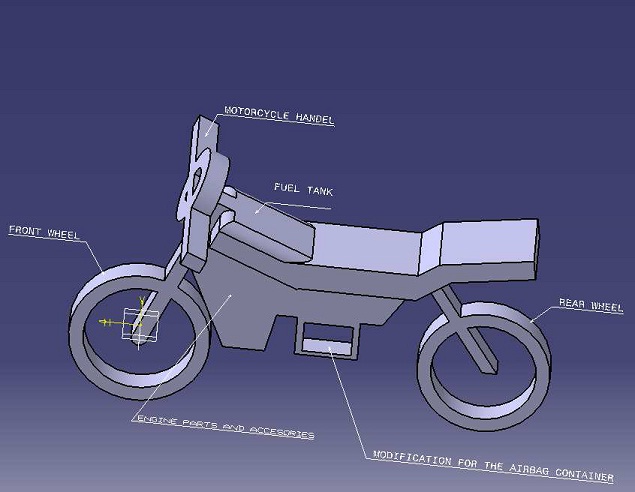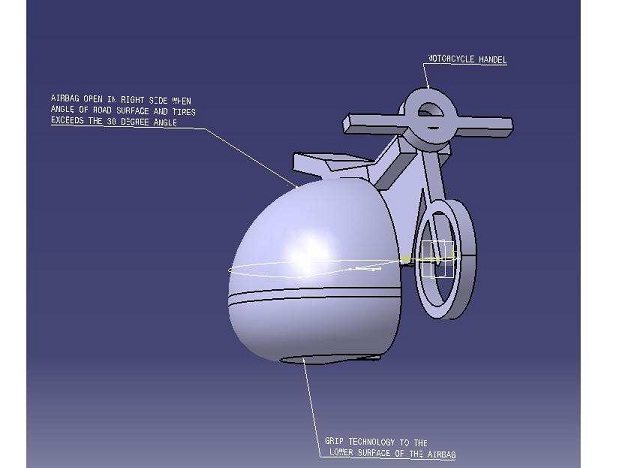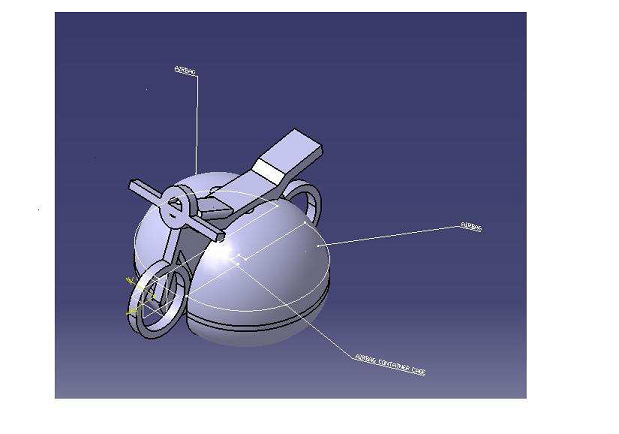





Published on Mar 01, 2025
The Airbag system is first introduced in 4-wheeler vehicles, this paper gives an information about the introduction of the airbag system can be used in the two wheelers(bikes) this paper shows the working, construction, installation and what will be problems can occurs are discussed. The concept of this airbag system is “To reduce the injuries to a rider when impacting with an opposing vehicle and/or opposing object in frontal collisions by absorbing rider kinetic energy and by reducing rider separation velocity from motorcycle in the forward direction.” With the help of the ANGLE sensor with an angle indicator and sense of the collision and the large frequency vibration for to open the air bag.
Nowadays the increment in the death rate of India is 20% because of the accidents on the highways hence this invention can help us to reduce the death rate by 7% to 10% since this can be used in the pedestrian and safety department. In 4 wheeler vehicle the operations is based on the collision of two vehicles or collision with any object. This system is installed in dashboard and the battery power is consumed for working of this system.
Over the last 50 years, the number of passenger cars has multiplied. As roads have become increasingly busy, the number of traffic accidents has also increased dramatically. The new system which can help to severity of injuries caused by frontal collision is to be made available on the new gold Wing motorcycle [7].In the 2-wheeler system there is installation of the airbag system in between and at both sides of the bike. There is usage of the battery of bike for working of system. There are two cases when system runs by both the angle difference calculation and collision of the 2 bikes or by the any accident of bike with any object.
There are following instruments used for the 2 wheeler AIRBAG system—
2.1 Air bag (leather material with grip technology)
2.2 Chemical cylinders for releasing the air or gas
2.3 Sensors (angle sensor and crash sensor)
2.4 Fitting cage
2.5 Angle measurement instrument (angle indicator)
2.6 Battery used (bike battery)
Airbags are stretchable fabrics or other materials that are tightly packed in various locations throughout your vehicle. These bags are compressed and kept in a small area. When there is an accident, the airbags fill up with air very quickly to provide a cushioning system for the people on the motorcycle so that they are not thrown around in the event of a crash. While this does not necessarily prevent total injury or death, it can be very helpful in cushioning the passengers in many cases.
- Strong leather with grips is used to construct the air bags.
- Especially as the lower surface of the air bags take the friction caused due to the road surface.
- The grip is used to avoid slipping or skidding of the bike on the oily or wet surface areas.
- The shape of the air bag is semi-circular “D” shape on both sides of the bike.
Actual opening of air bag is due to the chemical reaction occurred in between two chemical cylinders which are fitted at the bottom of bike. When an external force or collision of two objects with bike occur then those two chemical cylinders mixes with each other and the chemical reaction takes place inside the cylinder. At the outlet of the cylinder, the high pressure exhaust gas (air) is expanded from exit valve. The pressure can be controlled by pressure valve in between air bag and chemical cylinder. This exhaust air or gas is used to fill the air bag and hence an air bag will open.
The signals from the various sensors are fed into the Airbag control unit, which determines from them the angle of impact, the severity, or force of the crash, along with other variables. Each restraint device is typically activated with one or more pyrotechnic devices, commonly called an initiator or electric match. The electric match, which consists of an electrical conductor wrapped in a combustible material, activates with a current pulse between 1 to 3 amperes in less than 2 milliseconds. When the conductor becomes hot enough, it ignites the combustible material, which initiates the gas generator. In a seat belt pre-pensioner, this hot gas is used to drive a piston that pulls the slack out of the seat belt
The most important parts of the success of the airbag system are the sensors. These small pieces of electronics are designed to tell when the vehicle has been damaged in an accident. They respond to several different sets of stimuli, including sudden stopping, increased pressure as pieces of the motorcycle are moved due to the force of the collision, and angle between road surface and tires of motorcycle.
Different types of sensors measuring wheel speed, seat occupant status, brake pressure and impact, and other vehicle status indicators are monitored by the airbag control unit located in the front portion of the cabin. The sensors relay signals to the airbag control unit, which analyzes the data and can orchestrate safety features like seat belt lock, automatic door locks, as well as airbag deployment. Two types of airbag sensors used in automobiles are electrical and mechanical. Electrical sensors vary in design.
Some use an electromechanical "ball and tube" mechanism, which basically consists of a small tube containing a circuit switch and ball that's held together by a small magnet. If a collision occurs, the ball is dislodged from the magnet and rolls forward in the tube, hitting a switch that completes the electrical circuit. Other electrical designs are similar in principle, using a metal roller or spring loaded weight instead of a ball, Mechanical sensors work independent of the electrical system and respond similarly to the electrical sensors, with a design that actuates a firing pin triggering a small explosion after a crash. Since a mechanical sensor does not require a power source, it cannot be deactivated like an electrical sensor can when the battery is disconnected. The success of the airbag system relies upon the crash sensors working not only accurately but also extremely quickly, so the most expensive and technologically advanced part of the airbag system are here.
Once the control unit determines there is an accident, it sends a signal to the inflator system. The inflator sets off a chemical charge, producing an explosion of nitrogen gas, filling up the airbag. As the airbag fills up, it bursts through the paneling that contains it and order to protect you. This all happens in an instant, usually within 25 or 50 milliseconds. That translates to almost 200 miles per hour. The airbag then will deflate itself on its own once it deploys.
The TLE5012B is a 360° angle sensor that detects the orientation of a magnetic field. This is achieved by measuring sine and cosine angle components with monolithic integrated Giant Magneto Resistance (iGMR) elements. High precision angle values are achieved over temperature and lifetime using internal auto calibration algorithm. Data communications are accomplished with a bi-directional SSC Interface that is SPI compatible. The absolute angle value and other values are transmitted via SSC or via a Pulse-Width- Modulation (PWM) Protocol. Also the sine and cosine raw values can be read out. These raw signals are digitally processed internally to calculate the angle orientation of the magnetic field (magnet). The TLE5012B is a pre calibrated sensor. The calibration parameters are stored in laser fuses. At start-up the values of the fuses are written into Flip-Flops, where these values can be changed by the application specific parameters
• Giant Magneto Resistance (GMR)-based principle
• Integrated magnetic field sensing for angle measurement
• Full calibrated 0 - 360° angle measurement with revolution counter and angle speed measurement
• Two separate highly accurate single bit SD-ADC
• 15 bit representation of absolute angle value on the output (resolution of 0.01°)
• 16 bit representation of sine / cosine values on the interface
• Max. 1.0° angle error over lifetime and temperature with activated auto-calibration
• Bi-directional SSC Interface up to 8Mbit/s
• Supports SIL with diagnostic functions and status information
• Interfaces: SSC, PWM, Incremental Interface (IIF), Hall Switch Mode (HSM), Short PWM Code (SPC)
• 0.25 μm CMOS technology
• Automotive qualified: -40°C to 150°C (Junction Temperature)
• ESD > 4kV (HBM)
• RoHS compliant (Pb-free package)
Figure 3 shows that the modification is required for the storage of airbag. This cage is made up of metal strips with two openings for airbag.

From figure 4 motorcycle exceeds the angle less than 30 degree in between road surface and motorcycle tires by using an angle sensor, hence as given above chemical reaction takes place and airbag opens in right side of the motorcycle. In this figure 4 shows that the airbag contains Grips to the lower surface of it.
In figure 5 airbag open in both directions when any object collapse to the motorcycle. When any object collides with the motorcycle at that time the airbag open in both directions to protect the passenger who is riding.

Figure 7- airbag open in both directions when any object collapse to the motorcycle.

- When the proximity sensor is active then it will measure the angle between road surface and the tires of the bike.
- This angle is displayed on the angle indicator which is fitted near the speedometer on the handle.
- This indicator will give signal about the degrees in which the bike will turn/tilt.
- When the angle is less than 30 degrees to the right or to the left side, then the air bag will open.
The provision of air bags on motorcycles is more complex than installation in cars, because the dynamics of a motorcycle crash are more difficult to predict but we discuss following points on accident [6].These characteristics leads to act with very short reaction time and fast inflation but only if the motorcycle is involve in the accident the greater limit of these device is that they work properly only under the particular conditions Especially the rider must remain on the motorcycle during the accident and the impact dynamics must lead him to hit exactly thr part of his vehicle protected by airbags
-Hand/leg Cracks or fractures
-Head injury
-Bleeding from body parts
-Getting thrown from bike
We can get protection from the above mentioned bodily harms as described as, the air bag system opens from the bottom to the left or right side of bike; hence we can avoid hand/leg cracks or fractures. The diameter of the air bag when opened is more than height of the bike and that of the rider, hence head injury is avoided. As the material used in the air bag construction is light weight strong leather the chances of bike skidding or slipping is diminished and external injuries like scratches are avoided. The chances of the rider being thrown from the bike are avoided as the leather belts are provided on both sides of the bike to secure the legs of the rider. The material used for constructing these belts is similar to those used for constructing the seat belts in the cars.
By providing the total safety to the motorcycle rider by implanting the airbags in both sides of the motorcycle as mention in this paper we will reduce the fatality rate by 20% to 30%.by using this technology there is not only reduce the death rate but also we gives the total protection to the rider as well as motorcycle. The experimental research will show the how this system is useful and It may be published as soon as possible.
1. Bayerische Motoren Werke Aktiengesellschaft, “Everything you need to know about the airbag” Service Product Support, D-80788 Munich, Germany Editorial office: HörnerWieland, Gewerbepark 13, D-83052 Bruckmühl, Germany,
2. Takeshi Kuroe Hideo Namiki Satoshi Iijima, “Exploratory study of an airbag concept for a large touring motorcycle further research second report” Honda R&D Co., Ltd. Asaka R&D Center Japan Paper Number 05-0316
3. Published by Infineon Technologies AG 81726 Munich, Germany © 2011 Infineon Technologies AG All Rights Reserved. Edition 2011-06
4. Joseph S. Merola, a chemistry professor and associate dean of the College of Arts and Sciences at Virginia Tech, offers this explanation
5. Happian-Smith, J. and Chinn, B. P., “Motorcycle Airbag Systems” Ref: European Road Safety Observatory BP5: PTW Design and Protective Equipment